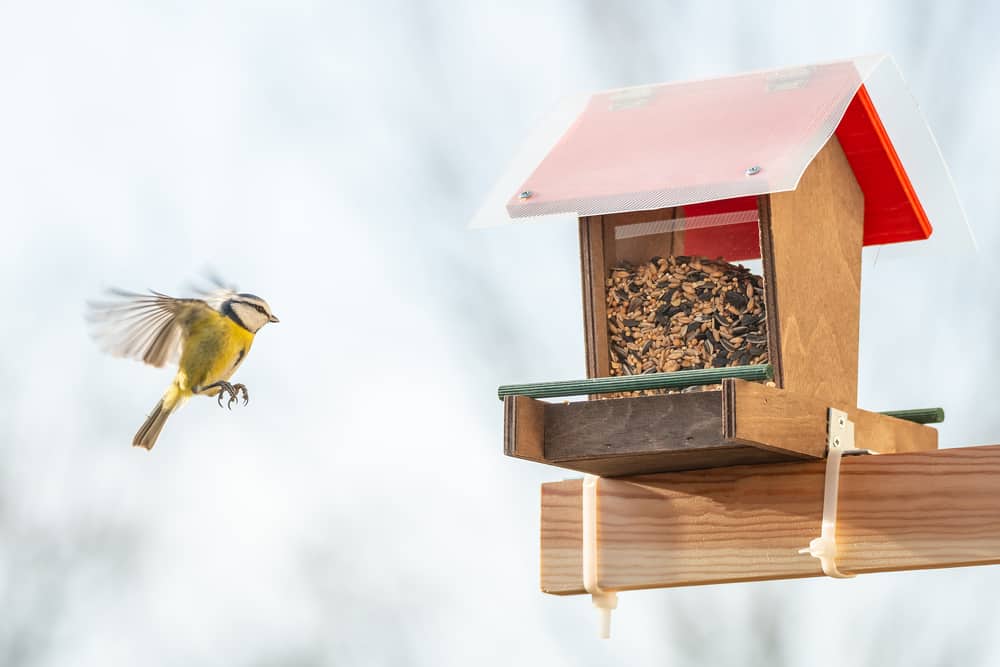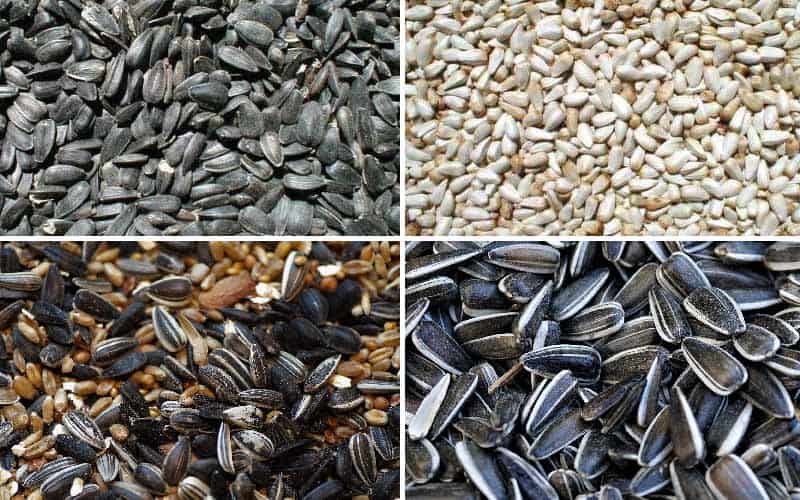Find out if balcony bird feeding is for you. Learn why you should or shouldn’t feed birds from your balcony and how to attract them if you do decide to put out a feeder.
Enjoying bird visitors on your home or apartment balcony is fun and beneficial to your local wildlife. However, it can be challenging to figure out how to attract birds to your balcony feeder, what type of feed is the best for the birds you desire, and how to get started.
Residential bird feeders appeared in 1845 when author Henry David Thoreau started using unripe corn to feed blue jays and black-capped Chickadees. Since then, people have built birdhouses and feeders using combinations of bird feeders and seeds to lure in the most beautiful birds.
Feeders accommodate almost every avian species, from goldfinches to hummingbirds, and are the most straightforward method to entice birds to your balcony. Read on for more information on balcony bird feeders, where to install one, and how to decide on the best bird seed for your new avian friends.
What Is a Balcony Bird Feeder?
A balcony feeder sits or hangs on your balcony. Some ground-level terraces and balconies use a protective screen, but most provide an open space for birds to enter and relax with their human companions.
Why You Should Install a Balcony Bird Feeder
Bird feeders have more benefits than you may think. Attracting birds to your balcony feeder can positively impact mental health by boosting vitamin D levels, allowing more presence of mind, and encouraging deep breathing and fresh air. And, you get to feed lovely creatures and enable them to enjoy their habitat.
Should you put a bird feeder on your balcony?
Whether or not you SHOULD put a bird feeder on your balcony is up to you and your landlord. Check your lease to make sure it’s not prohibited.
Also, use common sense. If you live in an area where bears commonly roam for food, a balcony bird feeder may not be a good idea. After all, birds can climb ya know!
Don’t believe me? Check out this hungry bear that did just that!
How To Attract Birds to a Balcony Feeder
There are many ways to attract birds to your balcony feeder. Attracting birds is easier when you own a home as you can install more substantial feeders, but there are ways to attract birds to your apartment balcony for feeding.
Many methods rely on a concept discovered in Japan in the 1980s called forest bathing. The forest bathing method uses live plants, flowers, and seeds natural to particular birds, draws them in, and lets you observe and spend time with your winged visitors in peace.
How To Attract Birds to an Apartment Balcony
Attracting birds to your apartment balcony may be challenging, but it is still possible. The best way to attract birds is to buy a birdseed mix for native birds in your area and use a large bird feeder.
The scent will drive them toward your balcony – although some birds have undeveloped senses of smell, some have evolved significantly. Additionally, use foliage and plants that the birds can sit on, hide in, or use as shade.
Also, birds need water. Place a small dish on your apartment balcony to keep them hydrated after eating.
How To Attract Birds to a Home Balcony
A home balcony bird feeder will be easier to adopt as you can use yard and lawn space to lure birds to your balcony. Start by placing a bird feeder on the lawn. Gradually move it closer to your porch or add multiple feeders to the rest of your yard.
If you notice birds flying into your window, try placing your feeder closer to the glass. Most birds run into windows after feeding.
What Is the Appropriate Height for a Balcony Feeder?
It is no surprise that birds love heights, so if you live on a high floor of an apartment building, you should have no issues attracting feathered friends to your balcony.
The standard height for a bird feeder falls between 3 and 10 feet, making it challenging for non-avian critters to snack on your bird food. Attaching your feeder to the awning or roof of your balcony should be the perfect height.
Types of Bird Feeders To Use
The type of bird feeder you choose depends primarily on the amount of space you have and your budget. Below are a few common types that birds prefer to visit.
Nectar Feeders
The nectar feeder type is easy to find and usually does not break the bank, as most fall between $5 to $10. They suit most small, medium, and large spaces, so they work for almost every balcony.
Nectar feeders especially attract hummingbirds due to their typical bright red color and liquid nectar (most birds prefer traditional seed, but the hummingbird ingests liquid nectar and bugs for protein). Orioles are also nectar-loving birds.
Tube Feeders
Tube feeders are ideal if you have frequent visits from hungry squirrels. Constructed with a slim plastic or metal tube that keeps the seed dry, the tube feeder accommodates species such as sparrows, grosbeaks, finches, and chickadees.
Try to find a metal tube feeder if you think squirrels will be an issue, as the grated metal is trickier for them to chew through. Birds that can eat upside down, such as goldfinches, will enjoy it too.
This feeder type also works well for various spaces, as you can purchase a single tube feeder or multiple connecting tubes. Apartment balconies will likely suit a single-tube setup, but balconies on large homes can use the more substantial models.
I use the Droll Yankee tube feeder for bird seed (affiliate).
Hopper Feeders
If you have ever used an automatic feeder for your dog or cat, hopper feeders work similarly (although likely more sanitary). They often resemble houses and have a tray along the bottom that dispenses food as visiting birds nibble.
Sometimes called house feeders, the hopper type keeps the seed dry and healthy as long as no water can get into the feeding chamber. They work well for sturdy balconies as they can get heavy, but most spaces should be able to attach one without issue.

Birds that frequent hopper feeders include finches, jays, cardinals, buntings, and grosbeaks.
I use the Woodlink hopper feeder (affiliate). It’s sturdy and very easy to clean.
3 Easy Methods to Install A Balcony Bird Feeder
It’s easy to hang a bird feeder in your yard. Just install a bird feeder pole and hang the feeder(s) from a wire (most feeders come with the hanging wire). Or, simply insert a shepherd’s hook into the ground and hang the feeder.
Hanging a bird feeder from a balcony requires a bit more creativity. Here are the 3 easiest methods:
- Insert a shepherd’s hook into a medium-large-sized planter and hang the feeder from the shepherd’s hook.
- Install a deck or rail-mounted shepherd’s hook (affiliate) to hang the feeder from.
- Set the feeder on a table. This method works best for a hopper-style feeder, which we’ll discuss shortly.
Types of Bird Seed To Use

There are dozens of seeds to choose from to make your new winged friends happy, healthy, and thriving. The most widely-loved germ that birds cannot get enough of is sunflower seeds. Almost all avians love black oil sunflower seeds.
Other choices include safflower, thistle, and millet.
I like to buy my birdseed from Chewy.com on autoship so I never run out. OnTheFeeder.com has partnered with Chewy.com to offer our readers the best deal on quality birdseed. Save 35% on your first order when you use this link: Save 35% on Chewy.com
Final Thoughts
Having a bird feeder on your balcony is a great way to connect with local wildlife. Figuring out how to attract birds to your veranda and choosing a bird feeder are genuinely fun activities that people of all ages enjoy.
There are plenty of options and benefits to having a balcony bird feeder. You can observe and learn about birds in your area, and you’ll also get a mental health boost from having a new set of winged friends who visit you.
Remember to clean your feeders and monitor the visitors to your balcony roost, and you will have a plethora of avians outside your door in no time.



